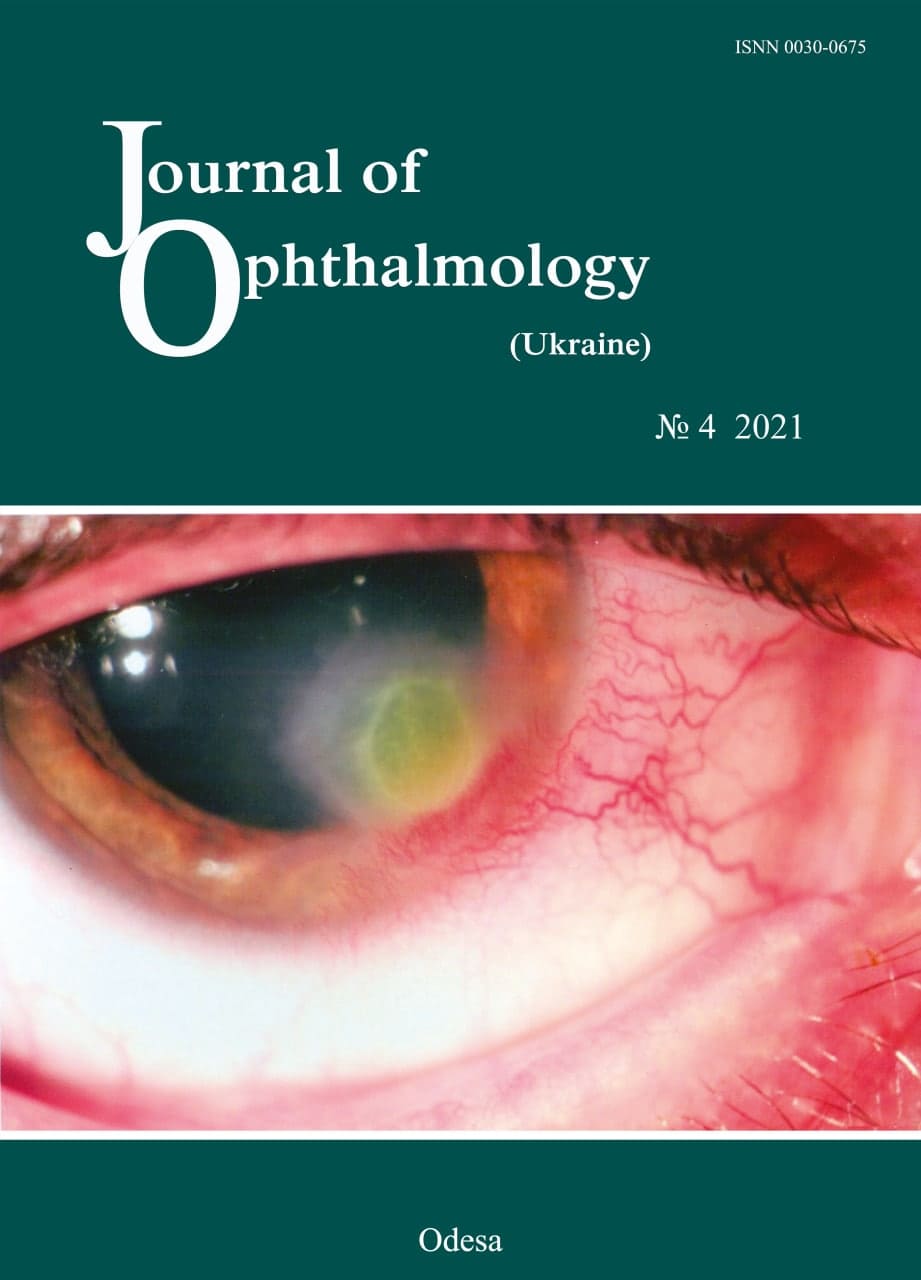Efficacy of orthokeratology lenses depending on topograpy pupil diameter and lens optical zone size
DOI:
https://doi.org/10.31288/oftalmolzh202146771Keywords:
myopia, refractive therapy, orthokeratology lenses, corneal topography, pupil diameterAbstract
Background: Management of progressive myopia is a major issue in current optometry and oph-thalmology in general. Refractive therapy with orthokeratology lenses (OKL) has become an in-creasingly popular technique for controlling the progression of myopia.
Purpose: To assess the efficacy of orthokeratology lenses depending on the topography pupil size and lens optical zone (OZ) size.
Material and Methods: Sixty children (117 eyes) with mild or moderate uncomplicated myopia were involved in this study. They underwent a comprehensive eye examination, corneal topography and pupillometry. Statistical analysis of correlations between the pupil diameter and axial elongation was performed. In order to conduct longitudinal surveillance of myopia, we compared two OKL designs, one with a conventional OZ diameter, and another with a smaller OZ diameter, for the efficacy of myopia control.
Results: The pupil diameter was inversely correlated with the axial elongation both in mild myopes (r = -0.48, p < 0.001) and in moderate myopes (r = -0.7, p < 0.001). Patients showed slower axial length progression when treated with a 5.5-mm OZ lens design than with a conventional 6.0-mm OZ lens design.
Conclusion: When examining a child with progressive myopia, it is important to pay attention to the photopic pupil size because the size may be a predictor of myopia progression and exert an influ-ence on the choice of correction. Orthokeratology lenses with a smaller (5.5-mm) optical zone diam-eter are more effective for myopia control, which should be taken into consideration when selecting a lens design for children.
References
1.Pan CW, Ramamurthy D, Saw SM. Worldwide prevalence and risk factors for myopia. Ophthalmic Physiol Opt. 2012; 32(1): 3-16. https://doi.org/10.1111/j.1475-1313.2011.00884.x
2.Smirnova IIu, Larshyn AS. [Current visual status among schoolchildren: prospects and challenges]. Glaz. 2011;3:2-8. Russian.
3.Moiseienko EO, Golubchikov MV, Mykhalchuk VM, Rykov SO. [Ophthalmological care in Ukraine in 2014-2017]. Kropyvny-tskyi: Polium; 2018. Ukrainian.
4.Poveshchenko IuL. [Clinical characteristics of disabling myopia]. Medychni perspektyvy. 1999;3:66-9. Ukrainian.
5.Mingazova EM, Samoilov Shiller SI. [Role of social and medical factors in the development of myopia]. Kazanskii meditsinskii zhurnal. 2012;6:958-61. Russiаn.https://doi.org/10.17816/KMJ2118
6.Lytvynchuk LM, Sergiienko AM, Rikhard G, et al. [Frequency of retinal complications in high myopia]. Ukrainskyi medychnyi almanakh. 2012; 5:109-10. Ukrainian.
7.Vitovska OP, Savina OM. [[The structure and sickness rate of eye and adnexa diseases in children in Ukraine]. Medicni perspek-tivi. 2015;3:133-8. Ukrainian.https://doi.org/10.26641/2307-0404.2015.3.53698
8.Rykov SO, Varyvonchyk DV. [Pediatric blindness and visual impairment in Ukraine: a situation analysis]. Kyiv: Logos; 2005. Ukrainian.
9.Lee EJ, Lim DH, Chung TY, Hyun J, Han J. Association of axial length growth and topographic change in orthokeratology. Eye Contact Lens. 2018; 44:292-8.https://doi.org/10.1097/ICL.0000000000000493
10.Chakraborty R, Read SA, Collins MJ. Hyperopic defocus and diurnal changes in human choroid and axial length. Optom Vis Sci. 2013; 90(11):1187-98.https://doi.org/10.1097/OPX.0000000000000035
11.Charman WN, Jennings JA. Longitudinal changes in peripheral refraction with age. Ophthalmic Physiol Opt. 2006;26:447-55.https://doi.org/10.1111/j.1475-1313.2006.00384.x
12.Charman WN, Radhakrishnan H. Peripheral refraction and the development of refractive error: a review. Ophthalmic Physiol Opt. 2010;30:321-38.https://doi.org/10.1111/j.1475-1313.2010.00746.x
13.Chen X, Sankaridurg P, Donovan L, et al. Characteristics of peripheral refractive errors of myopic and nonmyopic Chinese eyes. Vision Res. 2010;50:31-5.https://doi.org/10.1016/j.visres.2009.10.004
14.Chen Z, Niu L, Xue F et al. Impact of pupil diameter on axial growth in orthokeratology. Optom Vis Sci. 2012;89(11):1636-40.https://doi.org/10.1097/OPX.0b013e31826c1831
15.Downie LE, Lowe R. Corneal Reshaping Influences Myopic Prescription Stability (CRIMPS): an analysis of the effect of or-thokeratology on childhood myopic refractive stability. Eye Contact Lens. 2013;39:303-10.https://doi.org/10.1097/ICL.0b013e318298ee76
16.Faria-Ribeiro M, Navarro R, González-Méijome J, et al. Effect of Pupil Size on Wavefront Refraction during Orthokeratology. Optom Vis Sci. 2016; 93(11):1399-1408.https://doi.org/10.1097/OPX.0000000000000989
17.Faria-Ribeiro M, Queirós A, Lopes-Ferreira D, et al. Peripheral refraction and retinal contour in stable and progressive myopia. Optom and Vis Sci. 2013;90(1):9-15.https://doi.org/10.1097/OPX.0b013e318278153c
18.Marcotte-Collard R, Simard P, Michaud L. Analysis of two orthokeratology lens designs and comparison of their optical effects on the cornea. Eye Contact Lens.2018;44(5):322-9.https://doi.org/10.1097/ICL.0000000000000495
19.Carracedo G, Espinosa-Vidal TM, Martínez-Alberquilla I, Batres L. The Topographical Effect of Optical Zone Diameter in Or-thokeratology Contact Lenses in High Myopes. J Ophthalmol. 2019 Jan 2;2019:1082472. https://doi.org/10.1155/2019/1082472
Downloads
Published
How to Cite
Issue
Section
License
Copyright (c) 2025 Р. А. Пархомец

This work is licensed under a Creative Commons Attribution 4.0 International License.
This work is licensed under a Creative Commons Attribution 4.0 International (CC BY 4.0) that allows users to read, download, copy, distribute, print, search, or link to the full texts of the articles, or use them for any other lawful purpose, without asking prior permission from the publisher or the author as long as they cite the source.
COPYRIGHT NOTICE
Authors who publish in this journal agree to the following terms:
- Authors hold copyright immediately after publication of their works and retain publishing rights without any restrictions.
- The copyright commencement date complies the publication date of the issue, where the article is included in.
DEPOSIT POLICY
- Authors are permitted and encouraged to post their work online (e.g., in institutional repositories or on their website) during the editorial process, as it can lead to productive exchanges, as well as earlier and greater citation of published work.
- Authors are able to enter into separate, additional contractual arrangements for the non-exclusive distribution of the journal's published version of the work with an acknowledgement of its initial publication in this journal.
- Post-print (post-refereeing manuscript version) and publisher's PDF-version self-archiving is allowed.
- Archiving the pre-print (pre-refereeing manuscript version) not allowed.












